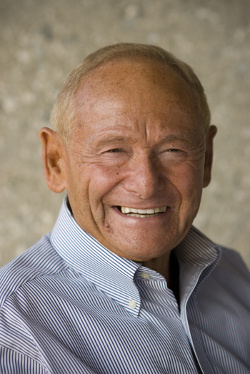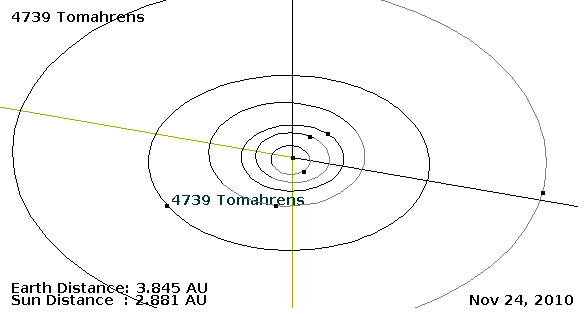Thomas J. Ahrens
December 13, 2010
Thomas J. Ahrens received his B.S. degree in
Geology-
Geophysics from
MIT in 1957, the same year that
Sputnik 1 was launched. Sputnik's launch on October 4, 1957, marked not only man's conquest of space, but the expansion of geology and geophysics beyond this terrestrial sphere. Ahrens, who was co-Investigator on the Cosmic Dust Analyzer Experiment for the
Cassini–Huygens Mission to
Saturn and a major participant in this new wave of geology, died on November 24, 2010, at age 74.[1-3]

Thomas J. Ahrens
(California Institute of Technology Photo)
After MIT, Ahrens continued in geophysics, earning an M.S. from the
California Institute of Technology in 1958, and a Ph.D. from
Rensselaer Polytechnic Institute in 1962. After his Ph.D., he became head of the Geophysics Section of the
Poulter Laboratory,
Stanford Research Institute, continuing there through 1967. In 1967 he became an Associate Professor at the California Institute of Technology and continued there his entire professional career. Ahrens was the Fletcher Jones Professor of Geophysics,
Emeritus, from 2005 until his death. One of his research interests was the investigation of the behavior of rocks and minerals during
impact and
shock excitation when they're subjected to high temperature and pressure, and he discovered shock induced
phase transitions in
carbonates. Such experiments illuminated the process of
impact crater formation on the moon and planets, and they also gave clues to the origin of
planetary atmospheres and
Earth's ocean.
Ahrens' shock excitation experiments may have been aided by his experience as a
Second Lieutenant at the
U.S. Army Ballistics Research Laboratory from 1959-60. The modern method for subjecting materials to
high pressure, the
diamond anvil cell, was not available at the time of his early research. According to his obituary in the Los Angeles Times,[2] Ahrens bought inexpensive
shotguns from
Sears to shoot specially crafted pellets at targets. Eventually, he scaled this shotgun approach to a thirty foot tube that used a pound of
gunpowder to fire an eighty gram
projectile. His apparatus eventually would fire projectiles at 18,000 miles per hour.
Ahrens' experiments on
iron at high temperature and pressure in the 1980s indicated that the temperature of Earth's
core was higher than believed. His estimate for a core temperature of 6900±1000 K was confirmed by a group at
Lawrence Livermore National Laboratory.[4] Ahrens argued also that Earth's water and atmosphere came from a later bombardment of icy
comets and not from its initial accretion of matter. His work on the chemical consequences of the terrestrial impact event that caused the
Chicxulub Crater in
Mexico led to the theory that the
extinction of dinosaurs 65 million years ago was caused by a meteor's impact on
limestone (
CaCO3) that released 10
16 kilograms of
carbon dioxide into the atmosphere. This would have heated the earth by 5-10
oC for 10,000 years.[4] Looking at the conditions surrounding the
Tunguska, Russia, impact event of 1908, Ahrens and John D. O'Keefe of
TRW Inc. concluded that the impactor was a low density comet, and not a high density
meteor.[2]
Ahrens published more than 375 papers. He served as Associate Editor,
Review of Scientific Instruments, 1972-74; Associated Editor,
Journal of Geophysical Research, 1972-74; and Editor, Journal of Geophysical Research (Solid Earth and Planets) 1979-1982. Among his honors were a Fellowship with the
American Geophysical Union, 1982; the Newcomb-Cleveland Prize of the
American Association for the Advancement of Science, 1984; Membership in the
U.S. National Academy of Sciences, 1992; and Fellowship with the American Association for the Advancement of Science, 1994. Ahrens was named a Foreign Associate of the
Russian Academy of Sciences in 1999. [3] A
Main Belt Asteroid, discovered by E. Bowell of
Flagstaff Observatory on October 15, 1985, was named after him in 1991 (
4739, Tomahrens; 1985 TH1).

Location of asteroid 4739 Tomahrens (1985 TH1) on November 24, 2010.
The Main Belt Asteroids, of which 4739 Tomahrens is a member, lie between the orbits of Mars and Jupiter. The positions of the Sun's first four planets and their orbits are indicated.
References:
- Thomas J. Ahrens, California Institute of Technology Press Release, December 1, 2010.
- Thomas H. Maugh II, "Thomas J. Ahrens dies at 74; Caltech geophysicist," Los Angeles Times, December 10, 2010.
- Curriculum Vitae - Thomas J. Ahrens, California Institute of Technology.
- Research - Thomas J. Ahrens, California Institute of Technology.
Permanent Link to this article
Linked Keywords: Thomas J. Ahrens; Geology; Geophysics; Massachusetts Institute of Technology; MIT; Sputnik 1; Cassini–Huygens Mission; Saturn; California Institute of Technology; Rensselaer Polytechnic Institute; RPI; Thomas Poulter; Poulter Laboratory; SRI International; Stanford Research Institute; Emeritus Professor; impact; shock excitation; phase transition; carbonate; impact crater; planetary; atmosphere; Earth; ocean; Second Lieutenant; U.S. Army Ballistics Research Laboratory; high pressure; diamond anvil cell; shotgun; Sears; gunpowder; projectile; iron; core; Lawrence Livermore National Laboratory; comet; Chicxulub Crater; Mexico; Cretaceous–Tertiary extinction event; extinction of dinosaurs; limestone; calcium carbonate; CaCO3; carbon dioxide; Tunguska, Russia, impact event; TRW Inc.; meteor; Review of Scientific Instruments; Journal of Geophysical Research; American Geophysical Union; American Association for the Advancement of Science; U.S. National Academy of Sciences; Russian Academy of Sciences; Main Belt Asteroid; Flagstaff Observatory; 4739 Tomahrens; 1985 TH1; Mars; Jupiter.